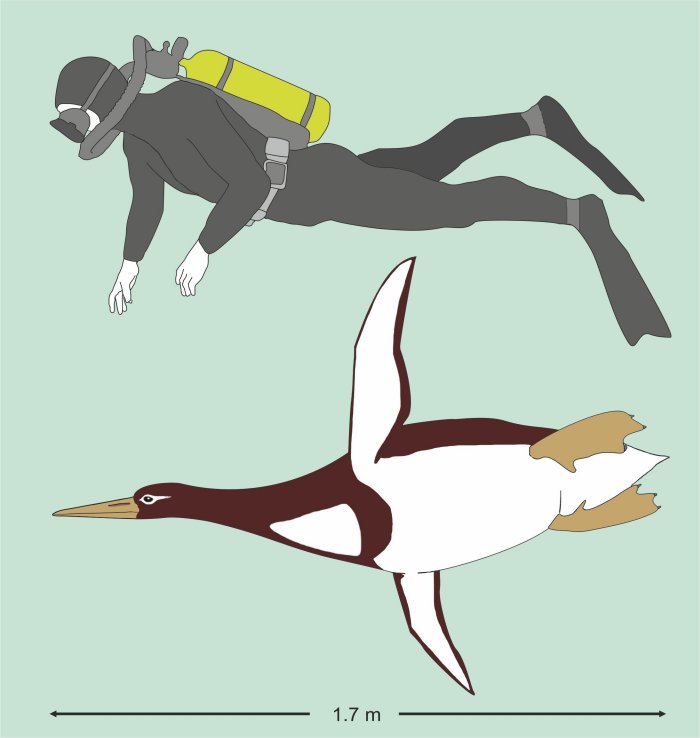Monster Bird ‘Kumimanu’ Was A Giant Penguin That Reached Human Height
The fossilized bones of an ancient very big penguin have been discovered in the Otago region on New Zealand’s South Island, once inhabited by giant birds.
The ancient bird measured about1.7 meters (5.5 feet) when swimming and weighed of 101 kilograms (223 pounds).

This illustration provided by Gerald Mayr shows the size of an ancient giant penguin Kumimanu biceae. Image credit: G. Mayr/Senckenberg Research
The giant bird is believed to be one of the world’s biggest extinct penguin species, according to researchers, who dubbed it ‘Kumimanu biceae’, which means in Maori – a large mythological monster.
The fossils of this bird are 56 million to 60 million years old, which means the creature lived in the Late Paleocene. These fossils are among the oldest known penguin remains.
“It is remarkable that even these early forms reached such an enormous size,” said German paleontologist and study co-author Gerald Mayr of the Senckenberg Research Institute and Natural History Museum in Frankfurt, Germany.
Mayr also said, the team examined the wing and leg bones of this penguin and recognized a previously unknown species. Two other very large pre-historic penguins but not as big as ‘kumimanu’ were earlier discovered in the same region New Zealand.
The researchers say that the seabirds’ huge size may be related to their inability to fly. According to Mayr, the species may have eventually died out with the emergence of other large marine predators such as seals and toothed whales.
“The penguins faced new competition and predation – which may have led to their extinction,” he said.
The question remains : why no penguin giants are alive today.
One hypothesis suggests that “giant penguins developed shortly after the mass extinction near the end of the Cretaceous, approx. 66 million years ago,”Mayr explained.
“It is possible that the disappearance of large marine reptiles enabled the penguins to explore new ecological niches. However, with the subsequent appearance of other large marine predators such as seals and toothed whales, the penguins faced new competition and predation – which may have led to their extinction.”
Research published in the scientific journal Nature Communications.



 Creators of mankind
Creators of mankind Description of “Tall white aliens”
Description of “Tall white aliens” Where they came from?
Where they came from? About hostile civilizations
About hostile civilizations The war for the Earth
The war for the Earth “Tall white aliens” about eternal life
“Tall white aliens” about eternal life Video: “Nordic aliens”
Video: “Nordic aliens” Aliens
Aliens Alien encounters
Alien encounters The aliens base
The aliens base UFO
UFO Technology UFO
Technology UFO Underground civilization
Underground civilization Ancient alien artifacts
Ancient alien artifacts Military and UFO
Military and UFO Mysteries and hypotheses
Mysteries and hypotheses Scientific facts
Scientific facts


















